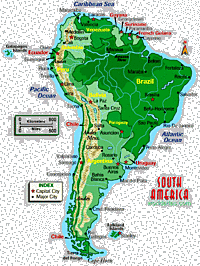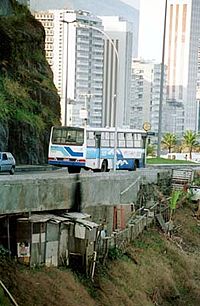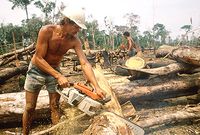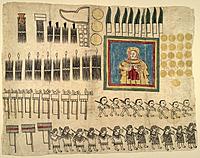|
|

South America is the world's fourth largest continent, covering 17,819,000 sq km, and the southern of the two continents of the Western Hemisphere. In 1991, its estimated population was 299,150,000, It is divided politically into 12 independent countries - Argentina, Bolivia, Brazil, Chile, Colombia, Ecuador, Guyana, Paraguay, Peru, Suriname, Uruguay, and Venezuela - and the overseas department of French Guiana. The continent extends c.7,640 km from Punta Gallinas, Colombia, in the north to Cape Horn, Chile, in the south. At its broadest point, near where it is crossed by the equator, the continent extends c.5,300 km from east to west. South America is connected to North America by the Isthmus of Panama; it is washed on the north by the Caribbean Sea, on the east by the Atlantic Ocean, and on the west by the Pacific Ocean.
Native peoples constitute a significant portion of the continent's Andean population, especially in Bolivia, Ecuador, Peru, and Paraguay. Elsewhere in South America, the population is generally mestizo, although Chile, Argentina, Uruguay, and Southern Brazil have primarily European populations. There are sizable populations of African descent in Northeast Brazil, French Guiana, Suriname, Guyana, Venezuela, and Colombia. Immigration since 1800 has brought European, Middle Eastern, and Asian (especially Japanese) peoples to the continent, particularly to Argentina and Brazil.
With the exception of Brazil and Ecuador, the national capitals have the largest populations and are the economic, cultural, and political centres of the countries. Since World War II, the urban population has rapidly expanded. São Paulo, Brazil, whose population is nearly 10,000,000, is the largest city of South America and one of the fastest growing cities of its size in the world. Squatter settlements have multiplied around urban areas as poor and unskilled people flock to the cities; widespread unemployment is common. Outside the cities, the population density of the continent is very low, with vast portions of the interior virtually uninhabited; most of the people live within 320 km of the coast.
 - Brazil: (Top) Squatters living under the Ipanema highway.
 - (Above) Charcoal production.
Economy
Beginning in the 17th century, the exploitation of the continent's resources and the development of its industries were the result of foreign investment and initiative, especially that of Spain, the United Kingdom, and the United States, but since World War II, the nations of South America have sought greater economic independence. An increasing number of South American industrial centres have developed heavy industries to supplement the light industries on which they had previously concentrated.
An early obstacle to industrial growth in South America was the scarcity of coal. The continent has therefore relied on its petroleum reserves, most notably in Venezuela and also in Argentina, Colombia, Chile, Peru, and Ecuador, as a source of fuel. South Americans also have gradually developed their natural-gas reserves; hydroelectric plants produce most of the continent's electricity. Iron-ore deposits are plentiful in the Guiana and Brazilian highlands, and copper is abundant in the central Andes mountain region of Chile and Peru. Other important mineral resources include tin in Bolivia, manganese and gold in Brazil, and bauxite in Guyana and Suriname.
Subsistence farming is widespread, with about 30% of the people working about 15% of the land. Dense forests, steep slopes, and unfavourable climatic conditions, along with crude agricultural methods, limit the amount of cultivable land. Commercial agriculture, especially of the plantation type, fares better in terms of production because of the large scale and the opportunity to use modern, mechanized methods. Among the agricultural exports are coffee, bananas, sugarcane, tobacco, and grains. Meat is also an important export. In the interior, hunting and gathering of forest products are the chief economic activities of the indigenous peoples. Fishing is also a central industry. In the more accessible areas, forest products are removed for export.
 - Sheet from the Huejotzingo Codex (1531) showing madonna and child.
Modern history
European exploration and penetration of South America started at the beginning of the 16th century. Under the Treaty of Tordesillas, Portugal claimed what is now Brazil, and Spanish claims were established throughout the rest of the continent with the exception of Guyana, Suriname, and French Guiana. An Iberian culture and Roman Catholicism were early New World transplants - as were coffee, sugarcane, and wheat. The subjugation of the indigenous civilizations was a ruthless accompaniment to settlement efforts, particularly those of Spain. The Inca Empire, centered at Cuzco, Peru, was conquered (1531-35) by Francisco Pizarro; other native cultures quickly declined or retreated in the face of conquest, conversion attempts, and subjugation. Spain and Portugal maintained their colonies in South America until the first quarter of the 19th century, when successful revolutions resulted in the creation of independent states.
The liberated countries generally struggled with political instability, with revolutions and military dictatorships common and economic development hindered. Between 1820 and 1920, the continent received almost 6 million immigrants, nearly all from Europe. Guyana gained independence from Great Britain in 1966 and Suriname from the Netherlands in 1975. French Guiana is an overseas department of France.
Beginning in the 1970s, road-building and the clearing of land led to the destruction of large areas of the Amazonian rain forests. International pressure and changes in government policy, especially in Brazil, resulted in a decrease in the deforestation rate since the late 1980s, although burning and illegal logging continue. Efforts to combat the illegal drug trade have been largely ineffective. Peru is one of the world's largest growers of coca leaves, and Colombia is a centre for the drug trade.
Economic problems and social inequality have led to considerable unrest and political instability. Many indigenous peoples, angered by centuries of domination by a primarily European-descended upper class, have demanded a more equal distribution of land and power. Despite the increasing industrialization of some countries, notably Brazil, Venezuela, and Argentina, and the widespread introduction of free-market reforms in the 1990s, high inflation and huge foreign debt continued to be major problems for many South American countries.
Source: Columbia Encyclopedia, Sixth Edition. 2004, Columbia University Press.
|
 |
 |
|

